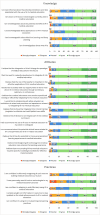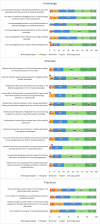Navigating the integration of artificial intelligence in the medical education curriculum: a mixed-methods study exploring the perspectives of medical students and faculty in Pakistan
- PMID: 39979912
- PMCID: PMC11844081
- DOI: 10.1186/s12909-024-06552-2
Navigating the integration of artificial intelligence in the medical education curriculum: a mixed-methods study exploring the perspectives of medical students and faculty in Pakistan
Abstract
Background: The integration of artificial intelligence (AI) into medical education is poised to revolutionize teaching, learning, and clinical practice. However, successful implementation of AI-based tools in medical curricula faces several challenges, particularly in resource-limited settings like Pakistan, where technological and institutional barriers remain significant. This study aimed to evaluate knowledge, attitudes, and practices of medical students and faculty regarding AI in medical education, and explore the perceptions and key barriers regarding strategies for effective AI integration.
Methods: A concurrent mixed-methods study was conducted over six months (July 2023 to January 2024) at a tertiary care medical college in Pakistan. The quantitative component utilized a cross-sectional design, with 236 participants (153 medical students and 83 faculty members) completing an online survey. Mean composite scores for knowledge, attitudes, and practices were analyzed using non-parametric tests. The qualitative component consisted of three focus group discussions with students and six in-depth interviews with faculty. Thematic analysis was performed to explore participants' perspectives on AI integration.
Results: Majority of participants demonstrated a positive attitude towards AI integration. Faculty had significantly higher mean attitude scores compared to students (3.95 ± 0.63 vs. 3.81 ± 0.75, p = 0.040). However, no statistically significant differences in knowledge (faculty: 3.53 ± 0.66, students: 3.55 ± 0.73, p = 0.870) or practices (faculty: 3.19 ± 0.87, students: 3.23 ± 0.89, p = 0.891) were found. Older students reported greater self-perceived knowledge (p = 0.010) and more positive attitudes (p = 0.016) towards AI, while male students exhibited higher knowledge scores than females (p = 0.025). Qualitative findings revealed key themes, including AI's potential to enhance learning and research, concerns about over-reliance on AI, ethical issues surrounding privacy and confidentiality, and the need for institutional support. Faculty emphasized the importance of training to equip educators with the necessary skills to effectively integrate AI into their teaching.
Conclusions: This study highlights both the enthusiasm for AI integration and the significant barriers that must be addressed to successfully implement AI in medical education. Addressing technological constraints, providing faculty training, and developing ethical guidelines are critical steps toward fostering the responsible use of AI in medical curricula. These findings underscore the need for context-specific strategies, particularly in resource-limited settings, to ensure that medical students and educators are well-prepared for the future of healthcare.
Keywords: Artificial intelligence; Curriculum; Deep learning; Medical education.
© 2025. The Author(s).
Conflict of interest statement
Declarations. Ethics approval and consent to participate: Ethical approval was obtained from the Ethical Review Committee of Liaquat National Hospital and Medical College (App# 0936–2023-LNH-ERC). Following ERC approval, the objective of the study was communicated to both faculty and students, and separate consents were obtained for both the quantitative survey and qualitative interviews. The participants had freedom to decline participation or to drop out at any time. No personal identification was disclosed, and participant data was coded. At all times, the research team protected the privacy and confidentiality of the data. Consent for publication: Not applicable. Competing interests: The authors declare no competing interests.
Figures
Similar articles
-
Refining AI perspectives: assessing the impact of ai curricular on medical students' attitudes towards artificial intelligence.BMC Med Educ. 2025 Jul 25;25(1):1115. doi: 10.1186/s12909-025-07669-8. BMC Med Educ. 2025. PMID: 40713579 Free PMC article.
-
Exploring dental faculty awareness, knowledge, and attitudes toward AI integration in education and practice: a mixed-method study.BMC Med Educ. 2025 May 12;25(1):691. doi: 10.1186/s12909-025-07259-8. BMC Med Educ. 2025. PMID: 40355937 Free PMC article.
-
Evaluation of Knowledge, Attitudes, and Practices among Healthcare Professionals toward Role of Artificial Intelligence in Healthcare.J Assoc Physicians India. 2025 Apr;73(4):e6-e12. doi: 10.59556/japi.73.0909. J Assoc Physicians India. 2025. PMID: 40200614
-
Mapping the use of artificial intelligence in medical education: a scoping review.BMC Med Educ. 2025 Apr 12;25(1):526. doi: 10.1186/s12909-025-07089-8. BMC Med Educ. 2025. PMID: 40221725 Free PMC article.
-
A systematic review and sequential explanatory synthesis: Artificial intelligence in healthcare education, a case of nursing.Int Nurs Rev. 2025 Jun;72(2):e70018. doi: 10.1111/inr.70018. Int Nurs Rev. 2025. PMID: 40243390 Free PMC article.
Cited by
-
Refining AI perspectives: assessing the impact of ai curricular on medical students' attitudes towards artificial intelligence.BMC Med Educ. 2025 Jul 25;25(1):1115. doi: 10.1186/s12909-025-07669-8. BMC Med Educ. 2025. PMID: 40713579 Free PMC article.
-
Utilisation of ChatGPT and other Artificial Intelligence tools among medical faculty in Uganda: a cross-sectional study.MedEdPublish (2016). 2025 Apr 28;14:245. doi: 10.12688/mep.20554.3. eCollection 2024. MedEdPublish (2016). 2025. PMID: 39911314 Free PMC article.
-
Problem-Based Learning and Case-Based Learning in Clinical Practical Teaching for Gynecology Residents: A Narrative Review.Adv Med Educ Pract. 2025 Jul 23;16:1269-1279. doi: 10.2147/AMEP.S534053. eCollection 2025. Adv Med Educ Pract. 2025. PMID: 40726960 Free PMC article. Review.
References
-
- McCarthy J. From here to human-level AI. Artif Intell. 2007;171(18):1174–82.
-
- Johnson L, Johnson L, Becker SA, Cummins M, Estrada V, Freeman A, et al. NMC Horizon Report: 2016 Higher Education Edition. New Media Consortium; 2016. 1–50 p. Available from: https://www.learntechlib.org/p/171478/. [cited 2024 Sep 6].
-
- Masoumian M, Hosseini T, Qayumi K. Integration of Artificial Intelligence in Medical Education: Opportunities, Challenges, and Ethical Considerations. J Med Educ. 2024Jan;1:22.
MeSH terms
LinkOut - more resources
Full Text Sources



